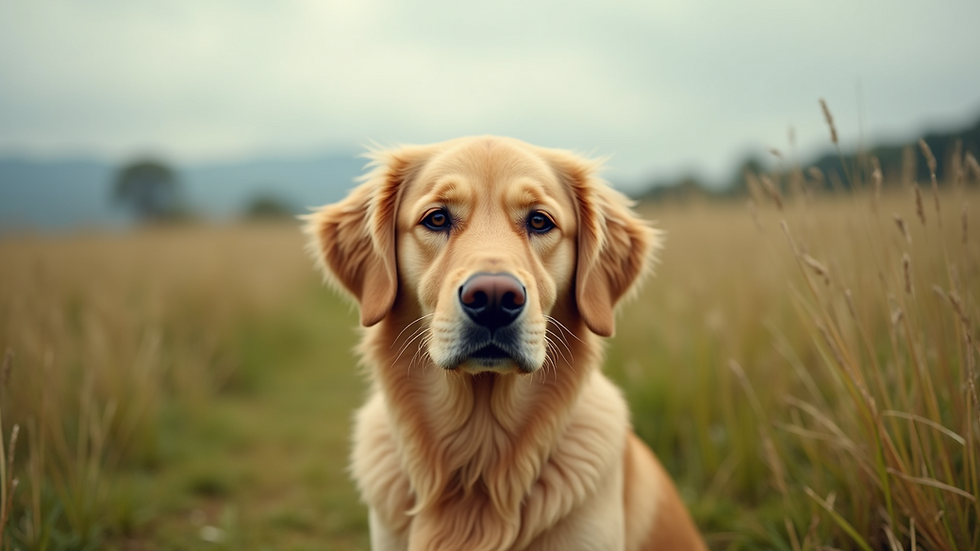Starting Your Golden Retriever Breeding Journey
- N..P, Maoribanks Perrelli

- Sep 6
- 4 min read
Breeding Golden Retrievers is a rewarding adventure that combines love for the breed with a commitment to health, temperament, and service. If you’re thinking about starting this journey, you’re stepping into a world where patience, knowledge, and care come together to create something truly special. Whether you want to contribute to the breed’s future or help provide highly trained service dogs, this guide will walk you through the essentials.
Understanding the Basics of Breeding Golden Retrievers
Before diving in, it’s important to understand what breeding Golden Retrievers really means. It’s not just about pairing two dogs and hoping for the best. Responsible breeding involves careful planning, health testing, and a deep respect for the breed’s characteristics.
Golden Retrievers are known for their friendly nature, intelligence, and versatility. These traits make them excellent family pets and service dogs. When you breed, your goal is to preserve these qualities while minimizing health risks.
Here are some key points to consider:
Health Screening: Both parents should be tested for common genetic issues like hip dysplasia, elbow dysplasia, and eye conditions.
Temperament: Choose dogs with stable, friendly temperaments. This ensures puppies grow up to be well-adjusted adults.
Pedigree: Look into the lineage to avoid inbreeding and maintain breed standards.
Purpose: Decide if your breeding will focus on family pets, show dogs, or service dogs.
If you want to explore potential mates, check out this list of male Golden Retrievers that meet high standards for breeding.

Preparing for Breeding Golden Retrievers: What You Need to Know
Once you’ve decided to breed, preparation is key. This phase sets the foundation for a healthy litter and a smooth experience.
Health and Veterinary Care
Schedule a full veterinary check-up for your female Golden Retriever before breeding. This includes vaccinations, parasite control, and reproductive health exams. Your vet can also advise on the best time for breeding based on your dog’s heat cycle.
Nutrition and Exercise
Good nutrition supports fertility and pregnancy. Feed your dog a balanced diet rich in protein, vitamins, and minerals. Regular exercise keeps her fit but avoid strenuous activity during heat and pregnancy.
Environment and Space
Prepare a clean, quiet, and comfortable space for whelping (giving birth). This area should be warm, safe, and free from distractions. Having a whelping box ready is a must.
Learning About the Process
Educate yourself on the breeding process, signs of heat, mating behavior, and potential complications. Books, reputable websites, and experienced breeders can be great resources.
Choosing the Right Mate
Selecting a mate is more than just looks. Consider health, temperament, and compatibility. The right match can improve the quality of your puppies and reduce health risks.

How long is a Golden Retriever pregnant for?
Understanding the pregnancy timeline helps you prepare for the arrival of your puppies. Golden Retrievers typically have a gestation period of about 63 days, but it can range from 58 to 68 days.
Signs of Pregnancy
Behavioral Changes: Your dog may become more affectionate or seek solitude.
Physical Changes: Look for a swollen abdomen and enlarged nipples.
Appetite: Some dogs eat less early on, then increase their food intake as pregnancy progresses.
Veterinary Care During Pregnancy
Regular vet visits are essential to monitor the health of the mother and puppies. Ultrasounds can confirm pregnancy and check on the developing pups.
Preparing for Whelping
As the due date approaches, prepare your whelping area and gather supplies like clean towels, heating pads, and a scale to weigh newborns.
What to Expect During Labor
Labor can last several hours. Puppies usually arrive every 20 to 60 minutes. Be ready to assist if necessary, but avoid unnecessary interference.

Raising Healthy Puppies: From Birth to Adoption
Once your Golden Retriever puppies arrive, your work is just beginning. Raising healthy, well-socialized puppies requires dedication and knowledge.
First Few Weeks
Keep the whelping area warm and clean.
Monitor puppies for nursing and weight gain.
Handle puppies gently to encourage bonding.
Socialization
Start socializing puppies early by introducing them to different sounds, sights, and gentle handling. This helps develop confident, friendly dogs.
Health Checks and Vaccinations
Schedule vet visits for vaccinations, deworming, and health checks. Keep detailed records for each puppy.
Finding Good Homes
Screen potential adopters carefully. Provide them with information about care, training, and health needs. A good home ensures the puppies thrive.
Supporting the Golden Retriever Community Through Responsible Breeding
Breeding Golden Retrievers is more than a hobby - it’s a responsibility to the breed and the community. By focusing on health, temperament, and service potential, you contribute to a better future for these wonderful dogs.
Organizations like Autumns Goldens are dedicated to preserving the breed’s integrity and training service dogs for those who need them most. By aligning your breeding efforts with such values, you help maintain the breed’s reputation and support meaningful causes.
If you’re ready to start your journey, remember that patience, education, and care are your best tools. Reach out to experienced breeders, join breed clubs, and stay informed. Your efforts will make a difference - one puppy at a time.
Happy breeding!
If you want to explore potential mates, check out this list of male Golden Retrievers that meet high standards for breeding.









Comments